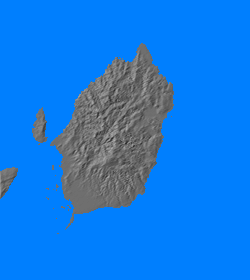![]() The Pacific War Online Encyclopedia
The Pacific War Online Encyclopedia
|
| Previous: Morishita Nobuei | Table of Contents | Next: Morozumi Gyosaku |

Morotai (128.29E
2.05N)
is an island about midway between the Philippines and the
western tip of New Guinea and
just north of Halmahera.
It is 44 miles (71 km) long and 25 miles (40 km) wide with an area of
695 square miles (1800 km2). The terrain is rugged and jungle-covered, with with four ranges
running northeast to southwest and reaching to 3575' (1090 meters) at
Mount Sabatai in the central range. Its only
feature of military interest was the Doroeba coastal plain on the
southwest
coast, which also had a protected anchorage
with a good roadstead to the west of Cape Gila but virtually
no facilities in 1941. The beaches east of Cape Gila were free of reefs and suitable for landings. The rest of the
island was fringed with reefs and much of the west coast was mangrove swamp. The population was 9000 natives and a single Dutch missionary. There were no
roads and only a few native trails.
The Japanese
attempted to build an airstrip
here, near the village of Pitoe, but abandoned the effort due to boggy terrain,
leaving a garrison of not more than 500 troops from 32 Division and 26 Special Base Force.
MacArthur originally
planned to seize Halmahera as a midway point between New Guinea and Mindanao, but the shortage of amphibious shipping forced
him to take less heavily defended Morotai instead. Landings by Hall's IX
Corps, led by 28,000 combat troops of 31 Division
transported by Barbey's
amphibious fleet, began on 15
September 1944. Troop lift consisted of a AGC, two Australian APAs, 5 APDs, 45 LSTs, 24 LCIs, 20 LCTs and 1 LSD screened by 24 destroyers and 27 minor warships.
The landings were covered by three American light cruisers, two Australian
heavy cruisers, and eight
American and two Australian destroyers under "Count" Berkey. Air support was
provided by six escort carriers
under Thomas Sprague and
by land-based aircraft
of 5 Air Force.
Distant cover was provided by Pacific
Fleet fast carriers under McCain.
So weak was enemy air power that the invasion force reached Morotai undetected.
Resistance was negligible, the only difficulty being that LCTs had
to come in on an unexpectedly muddy beach with numerous coral heads, and most of the vehicles
bogged down or drowned out coming ashore. By the end of the first day,
6000 men and 7200 tons of supplies
were brought ashore and only 2 Japanese were encountered. A weak
suicide charge was conducted by a small number of Japanese that night,
and mopping up continued the next day. Total Allied casualties were 31 killed or
missing and 85 wounded, while the Japanese lost at least 117 killed or
captured. Another 200 Japanese were killed when the barges on which
they were attempted to escape to Halmahera were destroyed by Allied PT boats. The remaining
Japanese fled into the rugged interior, where they were let be by the
Allied garrison.
An additional 12,200 service
troops were brought ashore in 73 LST loads and 19 Liberty Ship loads by the end
of the month. The Americans found the Japanese strip too boggy for
development and began
construction of a new 4000' (1220
meter) strip at
Wawama (128.323E 2.046N) almost at once. This was ready for fighters on 4 October 1944, medium bombers began
operations shortly thereafter, and heavy bombers began arriving on
19 October, the day before landings were to commence at Leyte. The airstrip was eventually
lengthened to 5000' (1520 meter) and a second runway begun in
September. Some 162 aircraft were based on
the field and an additional 20 Catalinas
and four squadrons of PT boats operated from the roadstead. The
Japanese attempted to reinforce the remnants of their garrison but were
unable to bring in supplies past the American naval blockade.
References
The Pacific War Online Encyclopedia © 2007, 2009-2010 by Kent G. Budge. Index